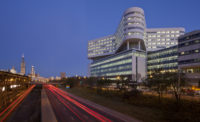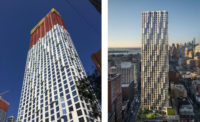Emotions are running high around 80 Flatbush, a massive mixed-use complex with a 74-story tower, planned for a site near Barclays Center, practically alongside Victorian row houses where Downtown Brooklyn meets the brownstones. If things go well for its developers, the project—which also includes a 38-story structure, two new schools and two 19th century commercial buildings to be repurposed as cultural venues—will become the latest to join the relentless march of luxury high-rise towers up Flatbush Avenue, from the East River to what was for decades Brooklyn’s tallest building: the 37-story, 500-foot-tall Williamsburg Savings Bank building, which is now called 1 Hansen Place. At almost 1,000 feet, 80 Flatbush will dwarf the 1929 building’s beloved Art Deco clock tower.
Last week, at the first public hearing of the city’s Uniform Land Use Review Procedure process (ULURP), area residents raised rallying cries of “Don’t block the clock!” and “Save our sunlight!” Meeting attendees—including community board members, elected officials, and neighbors, in addition to representatives of Alloy Development and the New York City Educational Construction Fund, which is building the proposed schools—filled St. Francis College auditorium in Brooklyn Heights on March 28. Testimony went into overtime as citizens voiced their objections to the project’s scale and density, a shortage of school seats, inadequate affordable housing (200 of the projected 900 apartments), overburdened transit, and other concerns, from trash to rats. State Senator Velmanette Montgomery went so far as to say, “The character and spirit of our neighborhoods are dying, and 80 Flatbush is killing it,” drawing sustained cheers and applause.
Alloy Development seeks rezoning for the irregular quadrilateral site to triple the allowable floor area ratio (FAR). Jared Della Valle, CEO of the Brooklyn-based development group, was met with hissing as he touted public benefits and changes already made to the design as a result of earlier community input (setbacks, street walls, partial masonry construction in lieu of glass), but he stood fast on Alloy’s intended FAR.
Construction has proceeded without this level of furor on other residential and office towers along Flatbush, including the 720-foot, 68-story Kohn Pederson Fox-designed Brooklyn Point, now under construction by Extell, and SHoP’s 78-story tower 9 DeKalb, a project of JDS Development Group, which will exceed 1,000 feet by its completion in 2020. Those two projects are situated on the westernmost section of Flatbush Avenue, which has long been a heavily trafficked commercial thoroughfare.
But where the diagonal avenue limns the brownstone neighborhoods of Boerum Hill and Fort Greene—where 80 Flatbush is planned—neighbors and other well-organized pioneers of gentrification are up in arms. As ULURP grinds forward over the next several months with additional meetings, hearings, and votes of the Land Use Committee, Community Board, Borough President’s Office and City Planning Commission, the most active of the community groups, the Boerum Hill Association (BHA), will lead the charge on behalf a coalition of brownstone communities, also including Park Slope and Brooklyn Heights. “We’re all concerned about the precedent of Manhattan-style density moving to Brooklyn,” says Howard Kolins, longtime president of the BHA. “I applaud Alloy for being willing to tweak the design, but there needs to be a new paradigm for Brooklyn, not just replicating Manhattan business district zoning.” As for what the ultimate outcome regarding 80 Flatbush is likely to be, says Kolins, “That I can’t tell you.”









Post a comment to this article
Report Abusive Comment